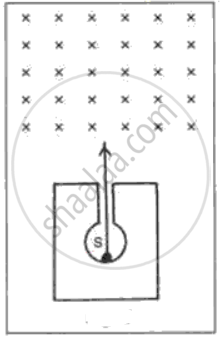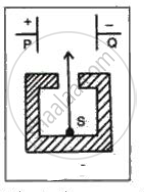Advertisements
Online Mock Tests
Chapters
2: Light
3: Sound
4: Current Electricity
5: Heat
▶ 6: Modern Physics
![Frank solutions for Physics - Part 2 [English] Class 10 ICSE chapter 6 - Modern Physics Frank solutions for Physics - Part 2 [English] Class 10 ICSE chapter 6 - Modern Physics - Shaalaa.com](/images/physics-part-2-english-class-10-icse_6:39af211da77c495e91d1cf4305988990.PNG)
Advertisements
Solutions for Chapter 6: Modern Physics
Below listed, you can find solutions for Chapter 6 of CISCE Frank for Physics - Part 2 [English] Class 10 ICSE.
Frank solutions for Physics - Part 2 [English] Class 10 ICSE 6 Modern Physics Exercise 6.1 i [Page 261]
What do you mean by Atomic number
What do you mean by Mass number.
What do you mean by Atomic mass
State the penetrating range of α, β and γ radiations.
Give the relative ionizing power of α, β and γ radiations.
Which of the radiations α, β and γ is similar to a beam of electrons?
State two similarities and two dissimilarities between the γ-rays and X-rays.
What happens to the position of an element in the periodic table when its nucleus emits an α - particle. Give reason for your answer.
What happens to the position of an element in the periodic table when its nucleus emits β -particle? Give reasons for your answer.
What happens to the position of an element in the periodic table when its nucleus emits γ radiation? Give reason for your answer.
What happens to the atomic number of element when (i) An α -particle, (ii) A β -particle 1 and (iii) γ-radiation is emitted?
What happens to the mass number of an element when (i) an α -particle, (ii) a β -particle, and (iii) γ -radiation is emitted?
A radioactive source emits three types of radiations. Name them.
(i) Name the radiations which are charged.
(ii) Name the radiations which are most penetrating.
(iii) Name the radiations which travel with the speed of light.
(iv) Name the radiations which have the largest mass.
What kind of change takes place in a nucleus when a β -particle is emitted?
In following fig. shows a mixed source S of alpha and beta particles in a thick lead container. The particles pass through a magnetic field in a direction perpendicular to the plane of paper (inwards as shown by x). State and show in the diagram how the particles get affected.

Frank solutions for Physics - Part 2 [English] Class 10 ICSE 6 Modern Physics Exercise 6.1 ii [Page 262]
In the following fig. shows a radioactive source S in a thick lead container. The radiations pass through an electric field between the plates P and Q. Complete the diagram to show the paths of α , β and γ radiations.

Why is the source S placed in a thick lead container?
A nucleus of an element X which has the symbol `""_84^202` X emits an alpha particle and then a beta particle. The final nucleus is `""_"b"^"a"` Y Find a and b.
The atomic number of a radioactive element is not changed when it emits ______.
A radioactive nucleus `""_"Z"^"A"` X first emits a beta particle and then an alpha particle to give the resulting nucleus `""_"Q"^"P"` Y What will be the values of P and Q in terms of A and Z?
Frank solutions for Physics - Part 2 [English] Class 10 ICSE 6 Modern Physics Exercise 1 [Page 266]
Make the correct choices in the following:
(a) In one atom of copper (mass number 63, atomic number 29) there are
63 protons and 29 neutrons.
63 protons and 29 electrons.
29 protons and 29 neutrons.
29 protons and 29 electrons.
29 protons and 63 neutrons.
A radioactive nuclide `""_86^226` Ra decays by emission of two alpha particles, one beta particle and gamma rays. Which of the following is the resulting nuclide X?
223 x 83
218 x 83
218 x 84
217 x 85
218 x 85
The element X has an atomic mass number of 238 and an atomic number
of 92. It emits an alpha particle forming an element y. Y can be represented
by
234 x 90
236 x 90
235 x 91
238 x 92
238 x 934
An element P has an atomic mass of 239 and an atomic number of 92. It
emits a beta particle forming an element Q. Q can be represented by
239 x 91
239 x 92
239 x 93
238 x 92
235 x 90
Which one of the following statements about alpha and beta particles is
correct?
They carry equal amounts of charge.
Each alpha particle has four times the mass of a beta particle.
Only alpha particles can cause ionization
They can both be deflected by magnetic fields when they are in
motion.Alpha particles have a larger range in air than beta particles.
Frank solutions for Physics - Part 2 [English] Class 10 ICSE 6 Modern Physics Exercise 2 [Page 267]
Define the term radioactivity. Of the three normally occurring radioactive radiations:
(a) Which has a positive charge?
(b) Which is most penetrating?
(c) Which has no electric charge?
Which of the following statements are correct?
Electrons have
No mass,
A mass less than that of a proton,
A mass equal to that of a helium atom,
Mass greater than that of a neutron.
Which of the following statements are correct?
Neutrons have
A double positive charge,
A single positive charge,
A negative charge,
No electric charge.
Draw a diagram of a simple atom showing the nucleus and electrons. In this atom:
(a) What type of charge will there be on the nucleus?
(b) What is the value of this charge?
One isotopes of uranium has a mass number of 235 and atomic number 92.
(a) What is the number of electrons in a neutral atom of this isotope?
(b) How many protons are there in the nucleus of this isotope?
(c) For another isotope of Uranium state which one of the numbers (238 or 92) changes?
(d) What is the number of protons in 238U?
Radioactive substances were found to give off three types of rays. Name them. How do they
(a) React to the magnetic field?
(b) React to the electric field?
(c) Act when different thickness of lead sheets is placed in their path?
What is the meaning of mass number?
What do you mean by atomic number?
In what way are these numbers related to the isotopes of an element?
Explain the use of radioactive in the field of medicine, agriculture and industry.
Distinguish between α, β and γ rays.
What do you understand by radioactive decay? An isotope of Uranium `""_92^238 "U"` is radioactive and changes into Thorium 92 by the emission of an alpha particle. Write a symbolic equation for this decay process.
The element `""_11^24 "Na"` changes to magnesium by the emission of a beta particle. Write down the symbolic equation for the beta emission.
What are the uses of radioactive isotopes in following?
(a) Medical field,
(b) Agriculture,
(c) Industries?
Solutions for 6: Modern Physics
![Frank solutions for Physics - Part 2 [English] Class 10 ICSE chapter 6 - Modern Physics Frank solutions for Physics - Part 2 [English] Class 10 ICSE chapter 6 - Modern Physics - Shaalaa.com](/images/physics-part-2-english-class-10-icse_6:39af211da77c495e91d1cf4305988990.PNG)
Frank solutions for Physics - Part 2 [English] Class 10 ICSE chapter 6 - Modern Physics
Shaalaa.com has the CISCE Mathematics Physics - Part 2 [English] Class 10 ICSE CISCE solutions in a manner that help students grasp basic concepts better and faster. The detailed, step-by-step solutions will help you understand the concepts better and clarify any confusion. Frank solutions for Mathematics Physics - Part 2 [English] Class 10 ICSE CISCE 6 (Modern Physics) include all questions with answers and detailed explanations. This will clear students' doubts about questions and improve their application skills while preparing for board exams.
Further, we at Shaalaa.com provide such solutions so students can prepare for written exams. Frank textbook solutions can be a core help for self-study and provide excellent self-help guidance for students.
Concepts covered in Physics - Part 2 [English] Class 10 ICSE chapter 6 Modern Physics are Isotopes, Isobars, Isotones or Isoneutronic, Radioactivity, Radioactivity as Emission of Alpha, Beta, and Gamma Radiations, Properties of Alpha Particles, Properties of Beta Particles, Properties of Gamma Radiations, Changes Within the Nucleus in Alpha, Beta and Gamma Emission, Alpha Decay (Alpha Emission), Beta Decay (Beta Emission), Gamma Decay (Gamma Emission), Uses of Radioactive Isotopes, Power Plants Based on Nuclear Energy, Safety Precautions While Using Nuclear Energy, Nuclear Fusion, Distinction Between the Radioactive Decay and Nuclear Fission, Distinction Between the Nuclear Fission and Nuclear Fusion, Nuclear Fission, Structure of the Atom and Nucleus, Atomic Model, Sources of Harmful Radiations, Hazards of Radioactive Substances and Radiation, Background Radiations.
Using Frank Physics - Part 2 [English] Class 10 ICSE solutions Modern Physics exercise by students is an easy way to prepare for the exams, as they involve solutions arranged chapter-wise and also page-wise. The questions involved in Frank Solutions are essential questions that can be asked in the final exam. Maximum CISCE Physics - Part 2 [English] Class 10 ICSE students prefer Frank Textbook Solutions to score more in exams.
Get the free view of Chapter 6, Modern Physics Physics - Part 2 [English] Class 10 ICSE additional questions for Mathematics Physics - Part 2 [English] Class 10 ICSE CISCE, and you can use Shaalaa.com to keep it handy for your exam preparation.
